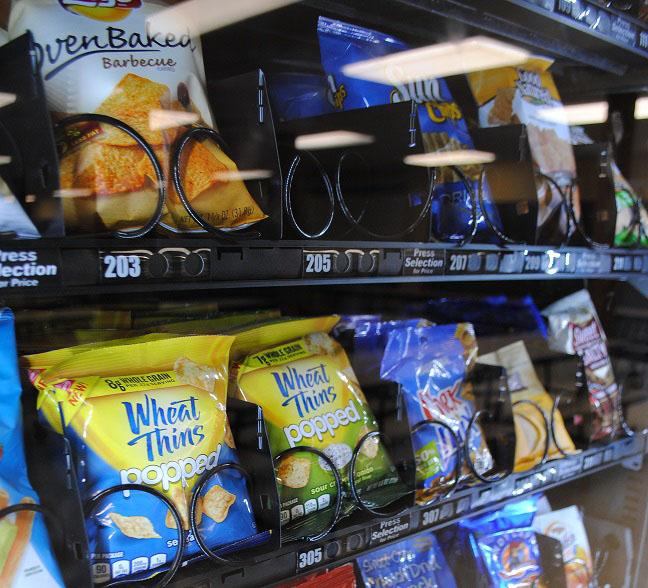Corn? Welcome to the new vending machine options
Traditional snack items have been replaced by healthier choices in AMSA’s vending machines.
The vending machines around AMSA’s campus were dormant and lifeless during the first weeks of the new school year, and then suddenly came back to life in late September, but with newer, healthier options.
Along with these healthier options, signs were placed next to the machines, explaining the nutrition information for each item.
Placing the nutrition facts next to vending machines “is mandated in Massachusetts for all vending machines,” said Eileen Hebert, AMSA’s lunch program director.
Nutrition awareness and calorie limitations on lunches at AMSA are due, in part, on federal efforts aimed at getting young people to eat better. It is an initiative dear to First Lady Michelle Obama, who is attempting to create a healthier America.
While the program has its detractors, the new vending machine options, along with the new lunches, make for a healthier lunchtime experience for students. They can now easily get information on allergens and other ingredients in foods so that they can make a more informed decision about their dietary experience at AMSA.
Along with the improved vending machines, Mrs. Hebert enthusiastically described a desire for the lunch program to get even better over the next few years.
“I just want to keep moving forward,” she said. “The new lunch menu is such a huge improvement from last year’s.”
Trying to understand all of the guidelines for lunch programs and vending machines in schools these days can seem almost as complicated as trying to finish a long calculus test in 10 minutes.
In an attempt to clarify things, Jessica Wohl reported in the Chicago Tribune in July that “snacks or side items sold in schools have to contain 200 calories or less, with no more than 239 milligrams of sodium.”
Additionally, snack foods must now be rich in whole grains, making it difficult, and potentially more expensive, for schools to run food programs.
Mrs. Hebert said that the overall feedback for the new lunch program and vending machines has been very good so far. Student feedback, however, has been mixed.
“I used to actually buy things from the vending machine, but now I don’t because either they have really bad food or they have the same types of food,” senior Tanya Rao said.
Tanya also complained about the prices and added that “most of the foods in the vending machines appear to have a lot more air in them than food.”
Many students feel as though the snack food restrictions are such that, by not allowing less healthy but more exciting options in the vending machines, students will be more likely to purchase unhealthy food outside of school, without moderation.
Sarah Burnett, a senior and athlete who trains on most days, hates the fact that she cannot buy a pack of M&Ms from the school vending machines when she wants an occasional diversion from an otherwise healthy diet.
“Literally, there is corn in our vending machines,” Sarah said. “Who is looking for a snack, and immediately thinks of corn? Outside of school these new snack foods are not keeping any kids from being unhealthy.”
The vending machines and the lunch program are works in progress, said Mrs. Hebert, who believes that they will only move forward and improve.

Sam Stiller is a senior at AMSA. He enjoys writing about what truly affects the everyday life of his peers. Sam is the editor of the student yearbook,...








Kavin Krishnan • Dec 18, 2014 at 9:45 pm
We should also mention how overpriced the snacks in the vending machine are this year and how little quantity each snack bag has. I remember in the 8th grade when snacks were 50 cents a piece. They have now doubled in price to $1 per snack.
It would not be a problem spending a dollar on each snack bag if the bag was [completely full]. The snack bags at AMSA tend to be partially filled with food. This discourages a lot of students to pay $1 per snack as they are not getting their money’s worth. Going back to 50 cents, half of the current price, per snack would be reasonable considering the bags are only HALF FILLED.